
by David Levinson
For a lot of people, February tops the list as their least favorite month. In the northern hemisphere, it’s cold and dark, and spring seems a long way off. The only things to break up the monotony are Valentine’s Day, which isn’t for everybody, and (most of the time) Carneval or Mardi Gras, which in the United States only matters if you’re near New Orleans and for lots of practicing Christians is immediately followed by giving up something nice for Lent.
As I look over my notes of newsworthy events for the last month, I see the usual things – coups, politics and power plays – but nothing that really catches my interest. Oh, there’s a couple of things that might develop into something, but they need time to come to fruition. Fortunately for my purposes, Fred Pohl has accidentally given us a little artistic puzzle to talk about, but let’s save that for the end.
The Words
In this month’s IF, the big Heinlein serial draws to a close and a brand-new serial begins. As does a new non-fiction series on fandom. Plus a new Saberhagen story. It’s a lot to whet a reader’s appetite, even if the cover is a bit mediocre. But that’s where our art mystery begins.
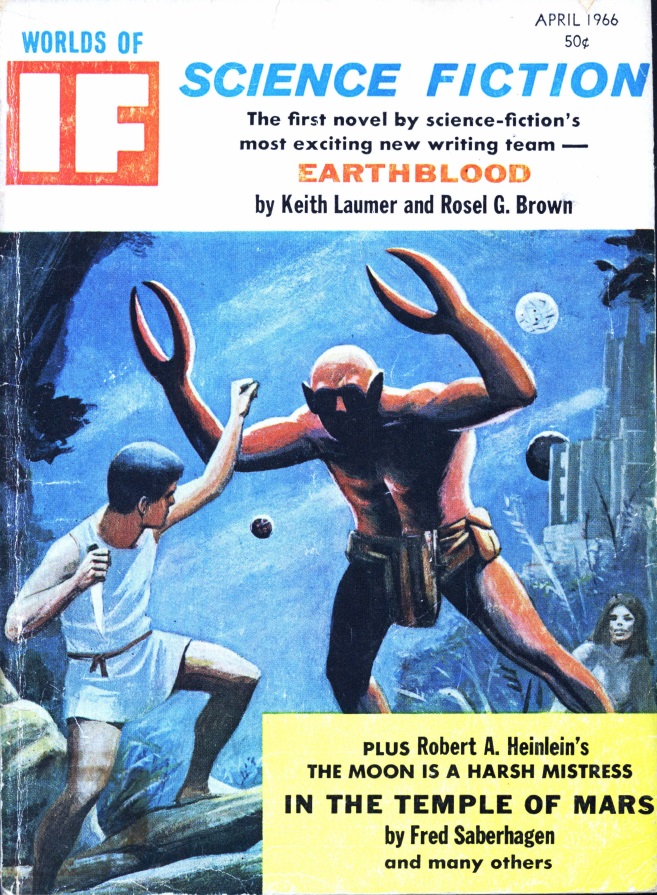
Roan’s first day on the job isn’t turning out well. Art attributed to Morrow
Earthblood, by Keith Laumer and Rosel George Brown
Millennia before our story starts, humanity went to the stars and found all other intelligent species still planet-bound. They formed a vast interstellar empire and ruled half the galaxy until the Niss came, shattered the human empire and ultimately blockaded humanity on Earth. Now the only humans at large in the galaxy are at the bottom of the socio-economic scale and most are heavily adapted to the planets they live on, with very few resembling the original terrestrial strain.
As the story opens, Raff Cornay, a human, and his wife Bella, a Yill, have come to Tambool to purchase an embryo to raise as their son. At great sacrifice, they wind up with a pure Terran stock human intended for the personal service of a recently toppled high official. What follows is a series of vignettes as Roan grows up, largely among the avian gracyl. At the age of 16, he tries to sneak into a circus, but is caught. In the ensuing fracas, his father is killed and Roan is dragooned into joining the Grand Vorplisch Extravaganzoo as a roustabout, sideshow attraction and high-wire walker. He meets and is befriended by the beautiful Stellaraire, seemingly a pure Terran human like him, but according to her a throwback and a sterile mule. It turns out the ship is a former Terran battleship. I’m sure that will be important later. At the end of the episode, Roan saves Stellaraire’s life and she asks him to take her back to her tent. To be continued.
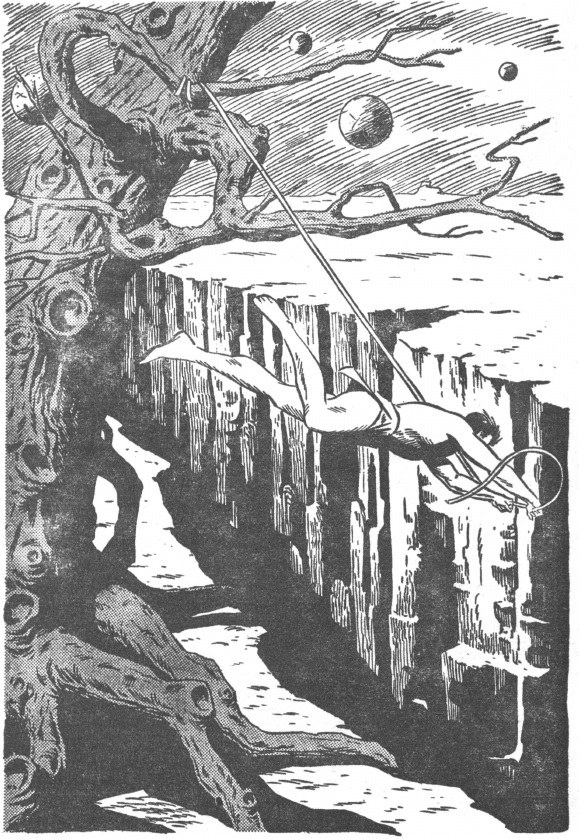
Tarzan… er, Roan learns to fly. He’s supposed to be 10. Art attributed to Nodel
I’m very much of two minds about this story. On the one hand, it’s a decent, if slightly pulpy, science fiction Bildungsroman. Beyond the names of some alien species (I recognized both Niss and Soetti) and maybe some of the action, I don’t see a lot of Laumer here. The writing and the plotting feel like they’re mostly from Rosel Brown. In general, that’s a good thing.
On the other hand, Roan gets a lot of stuff about human superiority pounded into him as he’s growing up. It’s uncomfortable language that we hear all too often in real life as an argument against civil rights and equality. It’s certainly possible that Roan will eventually come to see that every species has something to offer galactic society. Unfortunately, most of the aliens seem more like intelligent animals than sentient beings. They rely as much on instinct as they do intellect. Roan’s boss in the circus is confused by his need to practice; either he can do something or he can’t. That seems to be saying that humans really are superior.
Three stars for now.
Castles in Space, by Alma Hill
Aboard the Star Ship Sazerac, King Gurton Redbeard of Sazerac and King Karl of Ship Avlon are meeting over a game of chess, hoping to agree to a protocol which will allow them both to mine the asteroid swarm they are in without fighting over it. They are served by Redbeard’s daughter Kafri, and he offers her to Karl’s son in marriage to form a political alliance. As she wanders the ship late at night, trying to come to terms with her role as a bargaining chip, Kafri discovers that her father’s plan is not as it seems. Now she must make a decision as to which side she will support.
Long-time Boston fan Alma Hill was last seen with her rather disappointing ”Answering Service” in January of last year. This story, however, is quite good. Kafri is no mere political pawn, and this is very much her story. She’s decisive, active and drives the plot. Hill also took the story in a slightly different direction than I thought she was going, based on the ship name Avlon. A very solid three stars.
Our Man in Fandom, by Lin Carter
The first in a series intended, according to the introductory blurb, to teach casual readers “about fandom – what it is – and why”. Both F&SF and Amazing have gone down this road in some form or other in recent years. Here Carter traces one branch of fandom from the letter columns of the 20s and 30s to the fanzines of today. It’s a bit overly breezy and glib at points, but perhaps slightly less superficial than some of its predecessors. Once he gets through with the history and starts talking about current zines like Yandro and Amra, Carter offers a decent read. We’ll see how he does with other contemporary matters. Three stars.
In the Temple of Mars, by Fred Saberhagen
The Nirvana II, the new flagship for High Lord Felipe Nogara, is being brought to him beyond the edge of the galaxy. Aboard it, a prisoner named Jor is being brainwashed by the head of the Esteeler secret police to kill someone. Admiral Hemphill is the acting captain, and there are some other familiar faces. There are plots within plots. One faction hopes to rescue Johann Karlsen from his doomed orbit around a hypermassive star, while another has taken to worshipping the Berserkers, possibly in the hope of being declared goodlife. Everything comes to a head long before the ship reaches its destination.

Jor trains for gladiatorial combat to please the High Lord. And for something else. Art by Gaughan
This is a direct sequel to The Masque of the Red Shift and also features characters from Stone Place. No knowledge of those stories is needed to enjoy this one, but it would give this more weight. Another solid outing in the Berserker saga, with a couple of weaknesses. The extensive quoting from The Knight’s Tale, sometimes in the original Chaucerian English, feels a bit overdone. It was clearly part of Saberhagen’s inspiration and I applaud him not assuming we’ll all remember it from high school, but some cuts would help. And though the story comes to a definite conclusion, there is clearly more to tell. I suspect a fix-up novel in the not too distant future. Three stars.
The Pretend Kind, by E. Clayton McCarty
Little Tommy Wilson says he had a long chat with God in the woods down by the river. Despite efforts by his parents to get him to admit it’s just a story, he sticks to his guns. A neighbor and friend who is also a child psychologist is brought in to delve into this delusion. Things are not as they seem.
A generally forgettable story with an ending that can be seen from miles away. The biggest problem is that nobody actually listens to Tommy (not that it would have changed anything). The parents can be forgiven. They’re worried about their son either clinging tightly to a lie or going off to the woods with a stranger. But a psychologist, child or otherwise, should be listening to what his patient is telling him, and that doesn’t happen. Not good, not bad. A low three stars.
To Conquer Earth, by Garrett Brown
The Glom have arrived on Earth and they expect us to aid them in their galactic war. Landing for some inexplicable reason in Tierra del Fuego, the commander, Captain Crunch, eventually makes his way to President Hubert H. Hubris. Things do not go at all as expected.
Garrett Brown is this month’s first time author. I’d say his biggest influence here is Philip K. Dick, though this is nothing like a Dick story. It’s just the way most of the characters act. The concept isn’t terrible and in the hands of Ron Goulart or Keith Laumer, or better still Robert Scheckley this could have been really good. Alas, it is not. Two stars.
The Moon Is a Harsh Mistress (Part 5 of 5), by Robert A. Heinlein
As the last episode ended, Earth forces had landed on the Moon to put down the Lunar rebellion. The fight is intense, but not overly long, since the Earth troops are ill-prepared for low gravity. There are a number of casualties, among them Adam Selene. Mike has decided it’s time for Adam to become a martyr to the cause. Now it’s time for Luna to retaliate with rocks hurled from the cargo catapult. Mike and Prof have established a grid of targets all around the planet, designed to strike uninhabited areas (with the exception of the NORAD base at Cheyenne Mountain). The bombardment goes on for days and Earth strikes back again. In the end, Manny is alone at the secondary catapult, cut off from Mike, Prof and Wyoh. The fate of the revolution is in his hands.
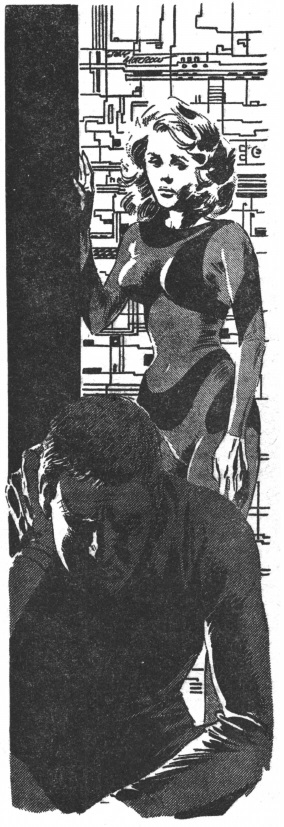
The pressure begins to wear on Manny. Art by Morrow
Oh my, what a finish. I have something to point out here and I’ll be circumspect, but I don’t want to lessen the impact of the ending. If you haven’t finished the story, skip down to the next paragraph. I don’t really think of Heinlein as a writer who evokes a lot of emotion apart from maybe a firm-jawed sense of justice or a manly swell of pride. But here, oh here, I’m not ashamed to admit the ending made me choke up. If only he could have dropped the last two paragraphs.
All right, safe for the uninitiated to read on. The novel shows Heinlein’s strengths and weaknesses to great effect. His ability to make the reader want to keep turning the page is here in full force, but it does get a little talky and some of the ways he presents women are questionable. Nevertheless, I’d say the strengths far outweigh the weaknesses. Plain and simple, this is the best thing Heinlein has written since Double Star, maybe ever. This could be his masterpiece. Five stars for this part and for the novel as a whole.
The Pictures
I promised you a bit of an art mystery. You may have noticed that under the cover and the illustration for Earthblood I said that the art is “attributed to” rather than “by”. Let’s start with the cover, said to be by Gray Morrow. But it really doesn’t look like his work. He favors strong, clear lines, rather than the slightly fuzzy work we see here. Frankly, it looks more like the work of Norman Nodel.
Interestingly, Nodel is given as the artist for the interior illustrations, yet this looks nothing like Nodel’s usual work. Indeed, it looks a bit more like Morrow’s work. It’s tempting to say they just swapped the artist names. But this also doesn’t look like Morrow’s work to me. The lines are there, but it’s sloppy in ways Morrow usually isn’t. The illo I included is supposed to show a ten-year-old boy, not a full-grown man. And look at these two excerpts.
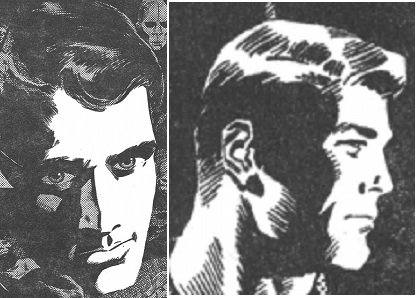
Art attributed to Nodel
These are supposed to be the same character at the same age. That age is supposed to be 16. Ricky Nelson there on the left might be 16, but Superman there on the right is 40 if he’s a day. If it’s not Morrow, then who? The other two artists in Fred Pohl’s main stable are Jack Gaughan and John Giunta, but both their styles are different. Right now, my best guess is Wallace Wood. Hopefully, we’ll find out next month, since the serials are given to a single artist.
Summing Up
All in all, a pretty good issue. There’s only one real stinker and while some of the others aren’t quite as good as they could be, they could also be a lot worse. The Heinlein serial has been the high point since it began and has outshone everything else alongside it. It does again this month, but this time it’s a diamond set in silver, not the tin that has mostly surrounded it.
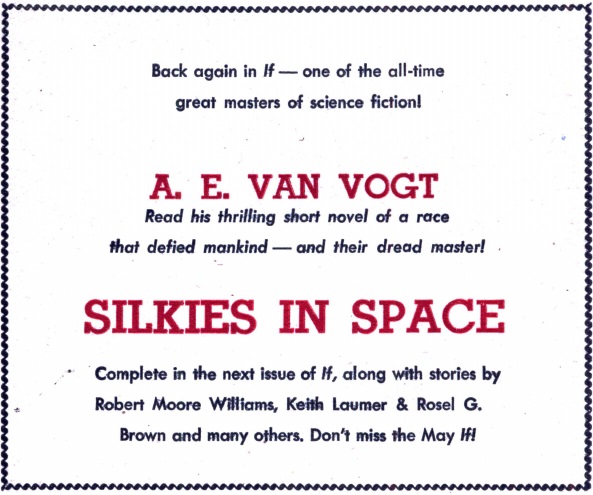
I fear next month may be something of a downturn.

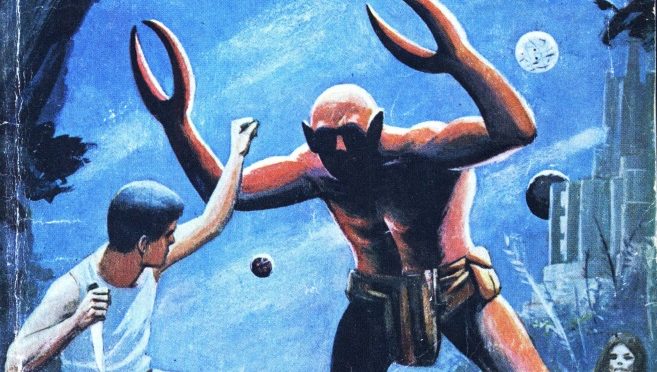

I'm betting the artist for the two heads and the leaping Tarzan-type figure was the notorious swipe-master Dan Adkins, not that I see swiping going on here. But he was famous for swiping images from other artists' work.
Dan Adkins, who undoubtedly did the weak cover, is primarily a swipe-master from Wallace Wood.
There are aspects of Wood's art one might criticize. His depictions of people in active motion, for instance, arguably look stiff as posed statues frozen in the middle of some movement, unlike the dynamic figures produced by his fellow comics master Jack Kirby. But Wood is generally considered one of the masters, both as penciller and inker, and Kirby used Wood as inker on his 'Sky Masters' newspaper strip for Wood's fine finishes.
Conversely, the rough inking on that right head profile is typical Adkins trying to imitate Wallace Wood. The head on the left_ could_ be Wood, but would be far from his best work. The cover, as I say, is Adkins without a doubt — the implausible, static poses of the figures there reflects the fact that one of the things Adkins swiped from Wood is the stiffness of Wood's figures in action. Only Adkins is far worse in this respect. The illustration for EARTHBLOOD with the Roan character in Tarzan-like pose is representative Adkins in terms both of its poor composition and inking.
Maybe Fred Pohl's art budget for this issue was tight after he finished paying Heinlein because pretty much all the art in it is pathetic, frankly. The Gaughan looks like something so rushed a ten-year-old might do it, while the Morrow — that implausibly distorted female physique — is pretty bad too.
It would actually make sense that the art budget was tight. I don't recall any discussion of this in previous reviews, but why did Fred even put Heinlein's MOON IN A HARSH MISTRESS in IF anyway — it is, as you say, some of Heinlein's strongest work ever — instead of his flagship mag, GALAXY? Clearly, he's trying to raise IF's standing and so he's allocating his budget for that mag to that end. Thus, art might have got shorted.
IF gets the serials, because it's monthly. Since Galaxy only comes out every other month,it would have taken a full year to run MOON. It's possible that IF being home to the serials is why the rest of the magazine has a tendency to lower quality, out of budgetary reasons.
I hadn't considered Adkins. He's possible for either the cover or the interiors. The smudginess of the cover feels like Nodel to me, but it could be Adkins. He's probably a better choice for the interiors, though. That drawing of what I called Superman is particularly bad. In physique he's more like Captain Marvel, which is ridiculous for a boy of 16 who grew up poor.
David L; 'IF gets the serials, because it’s monthly. Since Galaxy only comes out every other month,it would have taken a full year to run MOON.'
Ah, right.
As for the cover, it's Adkins. Trust me.
I'm actually really enjoying Earthblood — I'm betting all this Terran Supremacy stuff is going to get turned on its ear, and that in the end, it's all about individuals, no matter the race.
Skipping over the serials:
I didn't care much for "Castles in Space." The whole medieval feeling with starships seemed silly, and the love story (if it's worth even calling it that) was unbelievable.
It was odd to see more archaic stuff in space opera with "In the Temple of Mars," although it was a better story. Like the previous tale, it had love come out of nowhere at the end, but in this case, the author suggests a supernatural explanation! Anyway, despite some misgivings, I thought it was pretty good.
"The Pretend Kind" was obvious right from the start. Not terrible, but really, really predictable.
I can see the suggestion of Philip K. Dick in "To Conquer Earth," if that author were in a very silly mood. Maybe even Lafferty, in a particularly goofy way. Heck, even Anvil, with the would-be alien conquerors bested by the humans. In this case, it's not clever humans vs stupid aliens, but stupid humans vs stupid aliens. All in all, an odd, quirky farce. (Naming the alien commander after a recently introduced breakfast cereal!)
For me the serials are the only ones worth it here, with the shorts not being worth it.
I think I liked Earthblood a little better and Moon Is A Harsh Mistress a little less but both are good.
Great to see Rosel Brown back again. I agree little to Keith Laumer in this and much for the better. As we had McCafferty back in Analog, could we maybe talk Howard Fast into returning to F&SF and Naomi Mitchison into doing more SF novels?
The Heinlein was a very strong conclusion. The whole thing still had some flaws but I think it is the best Heinlein since his early novellas. Probably give 4 stars to the whole thing.